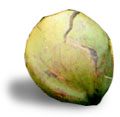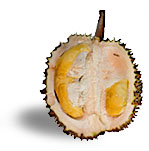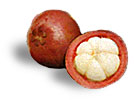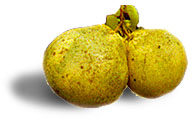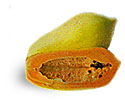| The
Ciku fruits are produced in frequent intervals throughout the year. The
fruits are round or oval, about 5 - 10cm long. Mature fruits have a dull
pale to rusty brown thin skin. When ripe the flesh is yellowish to pinkish
brown, soft, sweet and delicious. Unripe fruits are hard and unpleasantly
astringent. Each fruit has 2- 3 seeds about 1.5 - 2 cm long which are hard,
black, shiny and somewhat flattened. They are easily separated from the
flesh. |
Few
people need an introduction to the coconut, which has a worldwide following
due to its widespread use as a flavoring in candy, ice cream, and sauces.
Fresh coconuts are available year-round in Malaysia, and coconut milk is
present in a variety of culinary treats. The
peak season lasts from October to December. Choose one that's heavy for
its size and that sounds full of liquid when shaken; avoid those with damp
"eyes." |
"It
smells like hell and tastes like heaven," is a common description of the
durian, the national fruit. This large green fruit has a hard and spiny
exterior containing several soft, edible segments. Because of its pungent
smell, Malaysians also like to say that eating durian is "like eating ice
cream in a toilet." Despite its smell, it is by far the most loved
fruit in the country, and negotiations for a single fruit can easily last
ten minutes. Durians are also reputed to be phenomenal aphrodisiacs. |
Also
a native of tropical America, the guava is known for its musky aroma and
soft, delicious pulp. It has a thin greenish-yellow skin and a flesh of
varying thickness which may be white, yellow-pink or red. It is popularly
consumed in juice, ice cream, marmalade, and jam, and of course eaten raw. |
Those
who have never seen a jackfruit, or Nangka, are often surprised when they
see these hulking, yellow-green fruits for the first time. They can weight
up to 20 Kg, and inside are many bright yellow segments. They taste lightly
sweet, with a very enticing aroma. |
This
small purple-brown fruit (which is unrelated to the mango) has tasty white
segments inside with a tart, sweet flavor. The cooling, juicy fruit was
so loved by Britain's Queen Victoria that she offered a reward to anyone
who could import fresh ones to England. |
Though
it looks like a grapefruit, the pomelo's sweet taste is far closer to that
of an orange. It is the largest of the citrus fruits, and has a thick rind.
It is also known as jerunga.
|
The
papaya is oval with a thin, waxy skin; it is green-turning-to-yellow at
maturity, when its juicy sweet yellow flesh tastes
similar
to a cantaloupe. The papaya's flavor peaks out when its skin is 80 percent
colored. It is most commonly eaten fresh, peeled, seeded and cut into sections.
It also can be added to salads, baked and
served as a vegetable, made into sauce, jam, jelly, pickles, or juice. |
Though
the rambutan's hair like spines can look intimidating, they are actually
quite soft, and hide an incredibly sweet and succulent white fruit. The
outside of the fruit is bright red, and it grows in small bunches from
a tree. |
The
name is obvious once you see a starfruit for the first time. This waxy,
four-ridged fruit is one of the best thirst quenchers around, and it is
available almost anywhere in Malaysia. Its flesh is watery, crunchy, and
sweet. |

